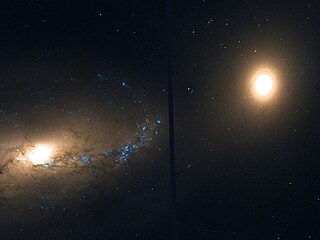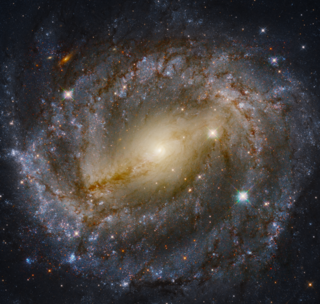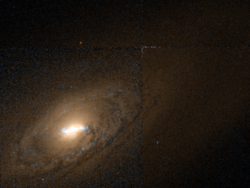An active galactic nucleus (AGN) is a compact region at the center of a galaxy that has a much-higher-than-normal luminosity over at least some portion of the electromagnetic spectrum with characteristics indicating that the luminosity is not produced by stars. Such excess, non-stellar emissions have been observed in the radio, microwave, infrared, optical, ultra-violet, X-ray and gamma ray wavebands. A galaxy hosting an AGN is called an active galaxy. The non-stellar radiation from an AGN is theorized to result from the accretion of matter by a supermassive black hole at the center of its host galaxy.

Seyfert galaxies are one of the two largest groups of active galaxies, along with quasars. They have quasar-like nuclei with very high surface brightnesses whose spectra reveal strong, high-ionisation emission lines, but unlike quasars, their host galaxies are clearly detectable.

NGC 3227 is an intermediate spiral galaxy that is interacting with the dwarf elliptical galaxy NGC 3226. The two galaxies are one of several examples of a spiral with a dwarf elliptical companion that are listed in the Atlas of Peculiar Galaxies. Both galaxies may be found in the constellation Leo. It is a member of the NGC 3227 Group of galaxies, which is a member of the Leo II Groups, a series of galaxies and galaxy clusters strung out from the right edge of the Virgo Supercluster.

NGC 3226 is a dwarf elliptical galaxy that is interacting with the spiral galaxy NGC 3227. The two galaxies are one of several examples of a spiral with a dwarf elliptical companion that are listed in the Atlas of Peculiar Galaxies. Both galaxies may be found in the constellation Leo. It is a member of the NGC 3227 Group of galaxies, which is a member of the Leo II Groups, a series of galaxies and galaxy clusters strung out from the right edge of the Virgo Supercluster.

NGC 4698 is a barred spiral galaxy located around 55 million light years away from Earth in the constellation of Virgo. It belongs to the Virgo Cluster of galaxies and is positioned near the northeastern edge of this assemblage. The morphological classification of NGC 4698 in the De Vaucouleurs system is SA(s)ab, which indicates a purely spiral structure with moderate to tightly wound arms. It is inclined to the line of sight from the Earth by an angle of 53° along a position angle of 170°.

NGC 4102 is an intermediate barred spiral galaxy located in the northern constellation of Ursa Major. It is visible in a small telescope and has an apparent visual magnitude of 11.2. The galaxy was discovered April 12, 1789 by William Herschel. J. L. E. Dreyer described it as "bright, pretty small, round, brighter middle and bright nucleus". This galaxy is located at a distance of 60 million light years and is receding with a heliocentric radial velocity of 837 km/s. It is a member of the Ursa Major group of galaxies.

NGC 5643 is an intermediate spiral galaxy in the constellation Lupus. Based on the tip of the red-giant branch distance indicator, it is located at a distance of about 40 million light-years. NGC 5643 has an active galactic nucleus and is a type II Seyfert galaxy.

NGC 6814 is an intermediate spiral galaxy in constellation Aquila. It is located at a distance of about 75 million light years from Earth, which, given its apparent dimensions, means that NGC 6814 is about 85,000 light years across. NGC 6814 has an extremely bright nucleus and is a type 1.5 Seyfert galaxy. The galaxy is also a highly variable source of X-ray radiation. The ultraviolet and optical emission also varies, although more smoothly, with time lag of two days. The cause of the lag and the smoothing of light curves is considered to be the reprocessing of the X-rays in the accretion disk. The cause of the active galactic nucleus is suspected to be a supermassive black hole with a mass about 18 million times that of the Sun. Many regions of ionised gas are studded along the dusty spiral arms.

NGC 708 is an elliptical galaxy located 240 million light-years away in the constellation Andromeda and was discovered by astronomer William Herschel on September 21, 1786. It is classified as a cD galaxy and is the brightest member of Abell 262. NGC 708 is a weak FR I radio galaxy and is also classified as a type 2 Seyfert galaxy.

NGC 7469 is an intermediate spiral galaxy in the constellation of Pegasus. NGC 7469 is located about 200 million light-years away from Earth, which means, given its apparent dimensions, that NGC 7469 is approximately 90,000 light-years across. It was discovered by William Herschel on November 12, 1784.

NGC 3367 is a barred spiral galaxy located in the constellation Leo. It is located at a distance of about 120 million light years from Earth, which, given its apparent dimensions, means that NGC 3367 is about 85,000 light years across. It was discovered by William Herschel on March 19, 1784.

NGC 7213 is a lenticular galaxy located in the constellation Grus. It is located at a distance of circa 70 million light-years from Earth, which, given its apparent dimensions, means that NGC 7213 is about 75,000 light-years across. It was discovered by John Herschel on September 30, 1834. It is an active galaxy with characteristics between a type I Seyfert galaxy and LINER.

NGC 7130 is a spiral galaxy located in the constellation Piscis Austrinus. It is located at a distance of about 220 million light years from Earth, which, given its apparent dimensions, means that NGC 7130 is about 100,000 light years across. It was discovered by John Herschel on September 25, 1834, and discovered independently by Lewis Swift on September 17, 1897. The location of the galaxy given in the New General Catalogue was off by 30 arcminutes in declination from the location of the galaxy.

NGC 1380 is a lenticular galaxy located in the constellation Fornax. It is located at a distance of circa 60 million light years from Earth, which, given its apparent dimensions, means that NGC 1380 is about 85,000 light years across. It was discovered by James Dunlop on September 2, 1826. It is a member of the Fornax Cluster.

NGC 4636 is an elliptical galaxy located in the constellation Virgo. It is a member of the NGC 4753 Group of galaxies, which is a member of the Virgo II Groups, a series of galaxies and galaxy clusters strung out from the southern edge of the Virgo Supercluster. It is located at a distance of about 55 million light years from Earth, which, given its apparent dimensions, means that NGC 4636 is about 105,000 light years across.

NGC 5846 is an elliptical galaxy located in the constellation Virgo. It is located at a distance of circa 90 million light years from Earth, which, given its apparent dimensions, means that NGC 5846 is about 110,000 light years across. It was discovered by William Herschel on February 24, 1786. It lies near 110 Virginis and is part of the Herschel 400 Catalogue. It is a member of the NGC 5846 Group of galaxies, itself one of the Virgo III Groups strung out to the east of the Virgo Supercluster of galaxies.

NGC 4278 is an elliptical galaxy located in the constellation Coma Berenices. It is located at a distance of circa 55 million light years from Earth, which, given its apparent dimensions, means that NGC 4278 is about 65,000 light years across. It was discovered by William Herschel on March 13, 1785. NGC 4278 is part of the Herschel 400 Catalogue and can be found about one and 3/4 of a degree northwest of Gamma Comae Berenices even with a small telescope.

NGC 2273 is a barred spiral galaxy located in the constellation Lynx. It is located at a distance of circa 95 million light years from Earth, which, given its apparent dimensions, means that NGC 2273 is about 100,000 light years across. It was discovered by Nils Dunér on September 15, 1867.

NGC 2617 is a Seyfert galaxy in the equatorial constellation of Hydra. It was discovered on February 12, 1885, by French astronomer Édouard Stephan. In 1888, Danish astronomer J. L. E. Dreyer described it as "extremely faint, very small, 2 very faint stars involved". It is located at an estimated distance of 202 million light years. In the infrared, the galaxy has an angular size of 0.693 by 0.652 arcminutes.

NGC 3516 is a barred lenticular galaxy in the constellation of Ursa Major. NGC 3516 is located about 150 million light years away from Earth, which means, given its apparent dimensions, that NGC 3516 is approximately 100,000 light years across. It was discovered by William Herschel on April 3, 1785.




















